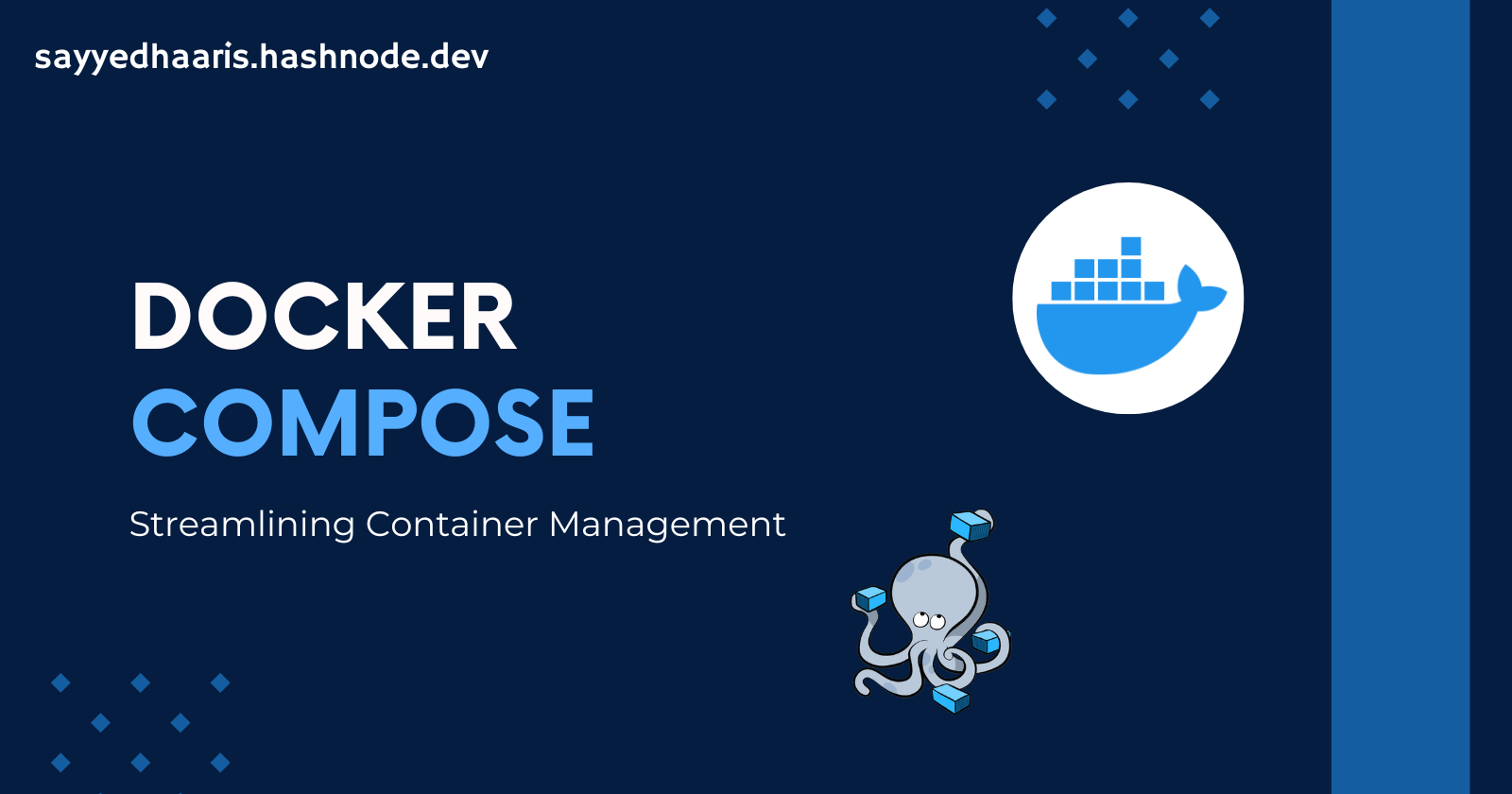Docker Compose
 Haaris Sayyed
Haaris Sayyed
Docker has revolutionized the way developers build, ship, and run applications. One of the key tools that complement Docker's functionality is Docker Compose. If you're new to Docker Compose or just looking to understand it better, this guide will provide you with a comprehensive overview of what it is, why it's useful, and how to get started.
What is Docker Compose?
Docker Compose is a tool that allows you to define and manage multi-container Docker applications. Using a simple YAML file, you can configure your application's services, networks, and volumes, and bring them up with a single command. This makes it easier to manage the complex dependencies and interactions between various parts of your application.
A Docker Compose file, typically named docker-compose.yml, is used to define and manage multi-container Docker applications. Here are some commonly used commands and configuration options that you can include in a Docker Compose file:
version: '3.8'
services:
service_name:
image: image_name:tag
container_name: container_name
ports:
- "host_port:container_port"
volumes:
- host_path:container_path
environment:
- ENV_VAR_NAME=value
networks:
- network_name
Key Concepts
Services: These are the different components of your application, each running in its own container.
Networks: Docker Compose sets up a network for your application services to communicate with each other.
Volumes: These are used to persist data generated by and used by Docker containers.
Why Use Docker Compose?
Docker Compose simplifies the process of developing and testing multi-container applications by providing a unified way to manage them. Here are some key benefits:
Simplified Configuration: Manage complex applications with a simple YAML file.
Ease of Use: Start your entire stack with a single command (
docker-compose up).Environment Management: Easily define different environments (development, testing, production).
Scalability: Scale services up or down with a single command.
Isolation: Each service runs in its own container, ensuring consistent environments across development, testing, and production.
Getting Started with Docker Compose
Installation
Before you begin, ensure that Docker is installed on your machine. Docker Compose is included with Docker Desktop for Windows and Mac, and can be installed separately on Linux.
To check if Docker Compose is installed, run:
docker-compose --version
Creating a docker-compose.yml File
The docker-compose.yml file is where you define your application's services, networks, and volumes. Let's create a simple example with a web application and a MySQL database.
version: '3'
services:
web:
image: nginx:latest
ports:
- "80:80"
volumes:
- ./html:/usr/share/nginx/html
db:
image: mysql:latest
environment:
MYSQL_ROOT_PASSWORD: password
MYSQL_DATABASE: testdb
MYSQL_USER: testuser
MYSQL_PASSWORD: testpassword
volumes:
- db_data:/var/lib/mysql
volumes:
db_data:
Running Docker Compose
Navigate to the directory containing your docker-compose.yml file and run:
docker-compose up
This command will:
Pull the specified images (nginx and mysql) if they aren't already available locally.
Create the defined volumes.
Set up the specified networks.
Start the containers for each service.
Interacting with Your Services
With your containers running, you can interact with them just as you would with any other Docker container. For example, you can use docker-compose exec to run commands in your containers:
docker-compose exec web bash
This will give you a shell inside the running web container.
Stopping and Removing Containers
To stop your running containers, press Ctrl+C in the terminal where docker-compose up is running, or run:
docker-compose down
This command stops and removes the containers, networks, and volumes created by docker-compose up.
Advanced Features
Docker Compose offers many advanced features to help manage your application:
Environment Variables: Use environment variables to configure your services dynamically.
Scaling Services: Scale your services with
docker-compose up --scale <service>=<number>.Override Configuration: Use multiple
docker-compose.ymlfiles to override configurations for different environments (e.g.,docker-compose.override.yml).
Demo : Environment Variables
You can define environment variables in your docker-compose.yml:
version: '3'
services:
web:
image: nginx:latest
ports:
- "80:80"
environment:
- NGINX_HOST=localhost
- NGINX_PORT=80
Or in an external .env file:
NGINX_HOST=localhost
NGINX_PORT=80
And reference them in your docker-compose.yml:
version: '3'
services:
web:
image: nginx:latest
ports:
- "${NGINX_PORT}:80"
environment:
- NGINX_HOST=${NGINX_HOST}
Demo : Scaling Services
To scale your web service to run three instances, use:
docker-compose up --scale web=3
This command will start three containers for the web service, automatically load-balancing them.
Demo :Override Configuration
version: '3.8'
services:
web:
image: nginx:latest
ports:
- "80:80"
environment:
- NODE_ENV=development # Set environment variable
volumes:
- ./html:/usr/share/nginx/html
db:
image: mysql:latest
environment:
MYSQL_ROOT_PASSWORD: ${MYSQL_ROOT_PASSWORD}
MYSQL_DATABASE: ${MYSQL_DATABASE}
MYSQL_USER: ${MYSQL_USER}
MYSQL_PASSWORD: ${MYSQL_PASSWORD}
volumes:
- db_data:/var/lib/mysql
volumes:
db_data:
Create a docker-compose.override.yml file for development:
version: '3.8'
services:
web:
environment:
- NODE_ENV=development
ports:
- "8080:80" # Use a different port for development
When running Docker Compose in development, use:
docker-compose -f docker-compose.yml -f docker-compose.override.yml up
This command merges the configurations from both files, with the settings in docker-compose.override.yml taking precedence.
Conclusion
Docker Compose is a powerful tool that simplifies the management of multi-container applications. By using a simple YAML file, you can define, run, and scale your entire application stack with ease. Whether you're a developer looking to streamline your workflow or a DevOps engineer managing complex environments, Docker Compose is an invaluable addition to your toolkit.
Experiment with Docker Compose, explore its advanced features, and see how it can enhance your development and deployment processes.
Happy containerizing!

Subscribe to my newsletter
Read articles from Haaris Sayyed directly inside your inbox. Subscribe to the newsletter, and don't miss out.
Written by
